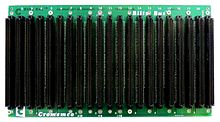S-100 bus
 |
|
| Year created | 1974 |
|---|---|
| Created by | Ed Roberts |
| Width in bits | 8 |
The S-100 bus or Altair bus, IEEE696-1983 (withdrawn), was an early computer bus designed in 1974 as a part of the Altair 8800. The S-100 bus was the first industry standard expansion bus for the microcomputer industry. S-100 computers, consisting of processor and peripheral cards, were produced by a number of manufacturers. The S-100 bus formed the basis for homebrew computers whose builders (e.g., the Homebrew Computer Club) implemented drivers for CP/M and MP/M. These S-100 microcomputers ran the gamut from hobbyist toy to small business workstation and were common in early home computers until the advent of the IBM PC (which some of them outperformed).
The S-100 bus is a passive backplane of 100-pin printed circuit board edge connectors wired in parallel. Circuit cards measuring 5 × 10-inches serving the functions of CPU, memory, or I/O interface plugged into these connectors. The bus signal definitions closely follow those of an 8080 microprocessor system, since the Intel 8080 microprocessor was the first microprocessor hosted on the S-100 bus. The 100 lines of the S-100 bus can be grouped into four types: 1) Power, 2) Data, 3) Address, and 4) Clock and control.
Power supplied on the bus was unregulated +8 V and ±16 V, designed to be regulated on the cards to +5 V (used by TTL) and ±12 V (typically used on RS-232 lines or disk drive motors). The onboard voltage regulation was typically performed by devices of the 78xx family (for example, a 7805 device to produce +5 volts). These were linear regulators which commonly were mounted on heat sinks.
The bi-directional 8-bit data bus of the Intel 8080 was split into two unidirectional 8-bit data buses. Later these two 8-bit busses would be combined to support a 16-bit data width for more advanced processors.
The address bus was 16-bits wide in the initial implementation and later extended to 24-bits wide. A bus control signal could put these lines in a tri-state condition to allow direct memory access. The Cromemco Dazzler, for example, was an early S-100 card that retrieved digital images from memory using direct memory access.
...
Wikipedia
